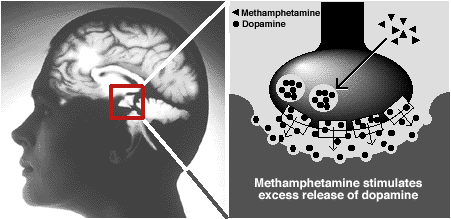National Institute on Drug Abuse
Research Report Series
Methamphetamine: Abuse and Addiction
How is methamphetamine used?
Methamphetamine comes in many forms
and can be smoked, snorted, orally ingested, or injected. The drug alters
moods in different ways, depending on how it is taken.
Immediately after smoking the drug or injecting it intravenously, the
user experiences an intense rush or "flash" that lasts only a few minutes
and is described as extremely pleasurable. Snorting or oral ingestion
produces euphoria -- a high but not an intense rush. Snorting produces
effects within 3 to 5 minutes, and oral ingestion produces effects within
15 to 20 minutes.
As with similar stimulants, methamphetamine most often is used in a
"binge and crash" pattern. Because tolerance for methamphetamine occurs
within minutes -- meaning that the pleasurable effects disappear even
before the drug concentration in the blood falls significantly -- users
try to maintain the high by binging on the drug.
In the 1980's, "ice," a smokable form of methamphetamine, came into
use. Ice is a large, usually clear crystal of high purity that is smoked
in a glass pipe like crack cocaine. The smoke is odorless, leaves a
residue that can be resmoked, and produces effects that may continue
for 12 hours or more.
| The
brain- Dopamine plays
an important role in the regulation of pleasure. In addition to
other regions, dopamine is manufactured in nerve cells within
the ventral tegmental area and is released in the nucleus accumbens
and the frontal cortex. |
 |
What are the immediate (short-term)
effects of methamphetamine abuse?
As a powerful stimulant, methamphetamine,
even in small doses, can increase wakefulness and physical activity
and decrease appetite. A brief, intense sensation, or rush, is reported
by those who smoke or inject methamphetamine. Oral ingestion or snorting
produces a long-lasting high instead of a rush, which reportedly can
continue for as long as half a day. Both the rush and the high are believed
to result from the release of very high levels of the neurotransmitter
dopamine into areas of the brain that regulate feelings of pleasure.
Methamphetamine has toxic effects. In animals, a single high dose of
the drug has been shown to damage nerve terminals in the dopamine-containing
regions of the brain. The large release of dopamine produced by methamphetamine
is thought to contribute to the drug's toxic effects on nerve terminals
in the brain. High doses can elevate body temperature to dangerous,
sometimes lethal, levels, as well as cause convulsions.
What are the long-term
effects of methamphetamine abuse?
Long-term methamphetamine abuse
results in many damaging effects, including addiction. Addiction is
a chronic, relapsing disease, characterized by compulsive drug-seeking
and drug use which is accompanied by functional and molecular changes
in the brain. In addition to being addicted to methamphetamine, chronic
methamphetamine abusers exhibit symptoms that can include violent behavior,
anxiety, confusion, and insomnia. They also can display a number of
psychotic features, including paranoia, auditory hallucinations, mood
disturbances, and delusions (for example, the sensation of insects creeping
on the skin, called "formication"). The paranoia can result in homicidal
as well as suicidal thoughts.
With chronic use, tolerance for methamphetamine can develop. In an
effort to intensify the desired effects, users may take higher doses
of the drug, take it more frequently, or change their method of drug
intake. In some cases, abusers forego food and sleep while indulging
in a form of binging known as a "run," injecting as much as a gram of
the drug every 2 to 3 hours over several days until the user runs out
of the drug or is too disorganized to continue. Chronic abuse can lead
to psychotic behavior, characterized by intense paranoia, visual and
auditory hallucinations, and out-of-control rages that can be coupled
with extremely violent behavior.
Although there are no physical manifestations of a withdrawal syndrome
when methamphetamine use is stopped, there are several symptoms that
occur when a chronic user stops taking the drug. These include depression,
anxiety, fatigue, paranoia, aggression, and an intense craving for the
drug.
In scientific studies examining the consequences of long-term methamphetamine
exposure in animals, concern has arisen over its toxic effects on the
brain. Researchers have reported that as much as 50 percent of the dopamine-producing
cells in the brain can be damaged after prolonged exposure to relatively
low levels of methamphetamine. Researchers also have found that serotonin-containing
nerve cells may be damaged even more extensively. Whether this toxicity
is related to the psychosis seen in some long-term methamphetamine abusers
is still an open question.
| Short-term effects can include: |
|
Increased attention and decreased fatigue
Increased activity
Decreased appetite
Euphoria and rush
Increased respiration
Hyperthermia
|
|
| Long-term effects can include: |
|
Dependence and addiction psychosis
- paranoia
- hallucinations
- mood disturbances
- repetitive motor activity
Stroke
Weight loss
|
|
|













